

COINAGE OF THE HERODIAN DYNASTY - VIRTUAL MUSEUM
In 40 BC the Roman Senate declared Herod the Great to be King of Israel due to the rebellion of Mattathias Antogonus, this decree was supported by Augustus Caesar (who at this time was still known as Octavian) and of Mark Antony who administered the Eastern provinces for Rome. By 37 BC Herod had cemented his power by capturing Jerusalem and executing the remaining supporters of the Macabee Dynasty. The last Macabee king, Mattathias Antogonus was handed over to Mark Antony who took him to Antioch. According to some sources Antony had Antigonus beheaded while others state that he was crucified.
To maintain his position Herod ruled with a iron fist, showing no mercy to even the slightest perceived threat to his authority. Executions became so commonplace that Herod even had his wife and two of his sons executed. Hearing of this Augustus commented that "it was better to be Herod's pig than Herod's son." When conflict arose between Augustus and Mark Antony, Herod (who had been a supporter of Antony up until this time) withdrew his support for Antony and prudently backed Augustus. It was near the close of Herod's long reign that, likely between 7-5 BC that Christ was born in Bethlehem. Herod undertook several building projects including a rebuilding and expansion of the Temple in Jerusalem and the establishment of the port city of Caesarea.
Herod died after a protracted and painful illness in 4 BC. According the to historian Josephus, the pain of his condition drove Herod to attempt to take his own life. His kingdom was divided among his three sons, Herod Archelaus, Herod Antipas and Herod Philip. In AD 6 Augustus decided that Herod Archelaus was inept and not fit to rule. He was stripped of his territory and a Roman official named Coponius was appointed to govern the region. Herod Antipas was the most unpopular of Herod's sons, not just with the people, but also with the Roman authorities. The Emperor Caligula removed him from power and banished him to Gaul in AD 40.
Herod Agrippa I was the grandson of Herod the Great and friend of the Emperor Caligula who (on becoming Emperor in AD 37) made him king of the area vacated by Herod Philip on his death in AD 34. When Herod Antipas was banished to Gaul in AD 40 Herod Agrippa I was also given his territory. Herod Agrippa I has the distinction of becoming one of the first persecutors of the Christians. Acts chapter 12 records Agrippa's execution of James, the brother of the Apostle John. James was one of the first Disciples of Jesus and became the first to suffer martyrdom. It is the recorded that Agrippa "was eaten by worms and breathed his last." His son Herod Agrippa II was still very young when his father died and his territory was ruled by Rome until he reached the age of maturity. He carefully aligned himself with the Romans and as a result enjoyed a long reign that lasted until his death in AD 95. He died childless and was the last of the Herodian Dynasty.
| Rulers of Israel During The
Herodian Dynasty: (those in bold letters issued coins) |
|
| Herod the Great | 40-4 BC |
| Herod Archelaus | 4 BC - AD 6 |
| Herod Antipas | 4 BC - AD 40 |
| Herod Philip | 4 BC - AD 34 |
| Herod Agrippa I | AD 37-44 |
| Direst Roman Rule | AD 44-55 |
| Herod Agrippa II | AD 55-95 |
 |
JUDAEA HERODIAN DYNASTY Herod the Great Bronze Prutah |
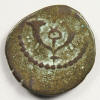 |
|
40-4 BC |
14mm 1.4g | Hendin-1188 |
The above coin, a bronze Prutah was issued at the Jerusalem Mint and is undated. The obverse shows an anchor and a double cornucopia is pictured on the reverse.
"Now after Jesus was born in Bethlehem of Judea in the days of Herod the king, behold, wise men from the east came to Jerusalem, saying, 'Where is he who has been born king of the Jews? For we saw his star when it rose and have come to worship him.' When Herod the king heard this, he was troubled, and all Jerusalem with him; and assembling all the chief priests and scribes of the people, he inquired of them where the Christ was to be born. They told him, 'In Bethlehem of Judea.'" Matthew 2:1-5
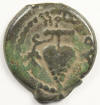 |
JUDAEA HERODIAN DYNASTY Herod Archelaus Bronze Prutah |
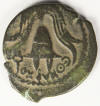 |
|
4 BC - AD 6 |
15mm 2.4g | Hendin-1196 |
This Prutah of Herod Archelaus depicts a bundle of grapes on the obverse and a crested helmet on the reverse. It was minted in Jerusalem.
"But when Herod died, behold, an angel of the Lord appeared in a dream to Joseph in Egypt, saying, 'Rise, take the child and his mother and go to the land of Israel, for those who sought the child's life are dead.' And he rose and took the child and his mother and went to the land of Israel. But when he heard that Archelaus was reigning over Judea in place of his father Herod, he was afraid to go there, and being warned in a dream he withdrew to the district of Galilee." Matthew 2:19-22
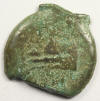 |
JUDAEA HERODIAN DYNASTY Herod Archelaus Bronze Half Prutah |
 |
|
4 BC - AD 6 |
13-14mm 1.4g | Hendin-1197 |
Issued by the mint at Jerusalem, the Half Prutah of Herod Archalaus above shows the prow of a ship on the obverse and has Archelaus' title in a wreath on the reverse.
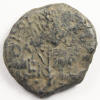 |
JUDAEA HERODIAN DYNASTY Herod Antipas Bronze Half Unit |
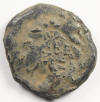 |
|
4 BC - AD 40 |
15-17mm 4.5g | Hendin-1208 |
This coin of Herod Antipas was issued in AD 30-31 at the Tiberias Mint. The obverse shows a palm branch and the reverse a wreath enclosing the inscription. To date only a single die for the wreath side of the coin has been observed. Coinage of Herod Antipas are second only to those of Herod Philip for rarity among the Herodians.
"But when Herod's birthday came, the daughter of Herodias danced before the company and pleased Herod, so that he promised with an oath to give her whatever she might ask. Prompted by her mother, she said, 'Give me the head of John the Baptist here on a platter.' And the king was sorry, but because of his oaths and his guests he commanded it to be given. He sent and had John beheaded in the prison" Matthew 14:6-10
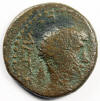 |
JUDAEA HERODIAN DYNASTY Herod Philip Bronze AE 22 |
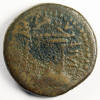 |
|
4 BC - AD 34 |
22mm 7.9g | Hendin-1221a |
The rarest coins of the Herodian Dynasty are those of Herod Philip. This example was minted in AD 8-9 at the mint of Caesarea Philippi and shows a bust of Augustus Caesar on the obverse and the temple known as the Augusteum Paneas (dedicated to the worship of Pan) on the reverse.
"In the fifteenth year of the reign of Tiberius Caesar, Pontius Pilate being governor of Judea, and Herod being tetrarch of Galilee, and his brother Philip tetrarch of the region of Ituraea and Trachonitis, and Lysanias tetrarch of Abilene, during the high priesthood of Annas and Caiaphas, the word of God came to John the son of Zechariah in the wilderness." Luke 3:1-2
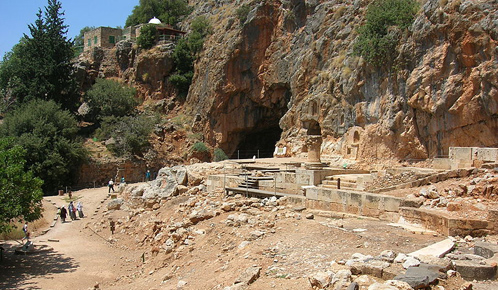
Ruined remains of the Augusteum Paneas at Caesarea Philippi with cave entrance behind
"Now when Jesus came into the district of Caesarea Philippi, he asked his disciples...'But who do you say that I am?' Simon Peter replied, 'You are the Christ, the Son of the living God.' And Jesus answered him, 'Blessed are you, Simon Bar-Jonah! For flesh and blood has not revealed this to you, but my Father who is in heaven. And I tell you, you are Peter, and on this rock I will build my church, and the gates of hell shall not prevail against it.'" Matthew 16:13-18 (excerpted)
It is thought by some that the exchange above took place in view of the Augusteum Paneas and that Jesus might have pointed to this temple when he said "the gates of hell."
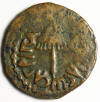 |
JUDAEA HERODIAN DYNASTY Herod Agrippa I Bronze Prutah |
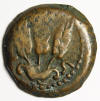 |
|
AD 37-44 |
17mm 3.0g | Hendin-1244 |
This coin of Herod Agrippa I was issued at the Jerusalem Mint in AD 41-42. The obverse shows an umbrella and the reverse three ears of grain. This is probably the most common coin issued by the Herodians.
"About that time Herod the king laid violent hands on some who belonged to the church. He killed James the brother of John with the sword." Acts 12:1-2
 |
JUDAEA HERODIAN DYNASTY Herod Agrippa II Bronze AE 26 |
 |
|
AD 55-95 |
26mm 11.9g | Hendin-1284b |
This fascinating coin was issued by Herod Agrippa II in AD 74-75 at the mint of Caesarea Philippi. The obverse shows the Roman general (and son of the Emperor Vespasian) Titus while a Victory advances to the right on the reverse holding a palm branch. This coin probably alludes to Titus' defeat of the Jews in the First Revolt that lasted from AD 66-70.
"So Agrippa said to Paul, 'You have permission to speak for yourself.' Then Paul stretched out his hand and made his defense...And Agrippa said to Paul, 'In a short time would you persuade me to be a Christian?'...And Paul said, 'Whether short or long, I would to God that not only you but also all who hear me this day might become such as I am'...Then the king rose, and the governor and Bernice and those who were sitting with them...Agrippa said to Festus, 'This man could have been set free if he had not appealed to Caesar.'" Acts 26 (excerpted)
CLICK HERE TO RETURN TO THE VIRTUAL MUSEUM LOBBY